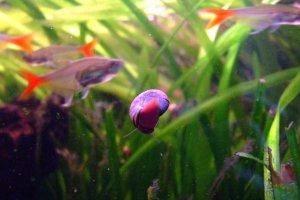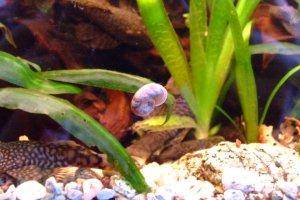Ramshorn Snails: Care, Diet, Breeding, and Tank Mates
Quick Navigation
Brief Description
Ramshorn snails are common in aquariums, sometimes introduced accidentally and sometimes added deliberately for their cleaning abilities. This guide covers everything you need to know, including their benefits, potential issues, and how to control their population. If you're interested in freshwater snails, you may also like these related articles: Aquarium Snails, Mystery Snails, and Freshwater Snail Types. Share your experience with Ramshorn snails in the comments below!
Introduction
Snails in an aquarium often spark mixed opinions among fish keepers. Some consider them a nuisance due to their rapid reproduction, while others appreciate their ability to help maintain a clean tank. The truth lies somewhere in between - Ramshorn snails can be both beneficial and challenging, depending on how they are managed.
Ramshorn snails are a collective term for various species in the aquarium trade. Despite minor differences, they are generally classified under the same name due to their similar appearance and behavior. Their distinctive coiled shells, resembling a ram's horn or a spiraled rope, give them their name.
These snails belong to the Planorbidae family, which is the largest group of aquatic pulmonate gastropods. Found on nearly every continent, they are lung-breathing snails rather than gill-breathers. Their pulmonary sac, located in the outer whirl of the shell, allows them to trap air using specialized folds of skin. If you shine a light through their shells, you might even see this air-filled space. Unlike many other snails, Ramshorn snails have only one pair of tentacles, with an eye positioned at the base of each.
Ramshorn snails come in two primary skin colors - black or red. The red coloration is due to the presence of hemoglobin in their blood, unlike many other snails, which have greenish blood due to hemocyanin. Their shells vary in shades from translucent to dark brown or black, creating a visually diverse and appealing addition to any aquarium.
Pros and Cons of Keeping Ramshorn Snails
Ramshorn snails often enter an aquarium unintentionally, hitchhiking on aquatic plants as clusters of eggs or juvenile snails. However, some aquarists deliberately introduce them for their tank-cleaning abilities and consider them a valuable part of the ecosystem.
These snails are excellent at removing algae, including surface algae on plants. While they generally do not consume healthy plants, they may feed on delicate species such as Cabomba and Anacharis.
Beyond algae control, Ramshorn snails act as a clean-up crew, consuming decaying plant matter and even unnoticed fish carcasses, helping to maintain water quality.
However, without natural predators, Ramshorn snails can quickly overpopulate a tank. If left unmanaged, their numbers can increase rapidly, leading to bio-load issues.
Suitable Tank Mates
If you plan to keep these snails in your tank, be mindful of their tank mates. Loaches and gouramis are natural snail predators and will quickly reduce the snail population. Even adult apple snails can pose a threat to Ramshorn snails, so it is best to avoid housing them together.
Ramshorn snails coexist well with peaceful fish species. Suitable tank mates include danios, guppies, and neon tetras, all of which tolerate their presence without issues.
Images
Reproduction
Ramshorn snails are hermaphroditic, meaning each individual possesses both male and female reproductive organs. This allows them to breed rapidly, even if only two snails are present in the aquarium. Once introduced, they will reproduce continuously without requiring any intervention from the fish keeper.
The red Ramshorn snail has become less common in the aquarium trade compared to previous years. This decline is due to interbreeding with brown and black Ramshorn snails, which tend to have dominant genes. As a result, the majority of offspring inherit the darker coloration, leading to fewer red individuals over time.
Without natural predators, Ramshorn snails can quickly overpopulate a tank. To maintain healthy breeding conditions, the water should be kept slightly alkaline, with a temperature between 75 to 80°F (24 – 26°C).
Dietary Needs
Ramshorn snails thrive on a varied diet that includes green vegetables such as spinach or lettuce. Before feeding, it is recommended to rinse the vegetables under warm water to slightly break down the cell structure, making them easier to consume. They also feed on algae and leftover fish food. If housed with hardy plants, they pose no threat, but delicate species may suffer damage as the snails search for algae.
Water Parameters
For healthy growth, Ramshorn snails prefer slightly alkaline water with a pH of 7.0 – 7.5 and a temperature range of 75 – 80°F (24 – 26°C). Hard water is ideal as it helps maintain strong shell development, while soft water can lead to shell erosion over time.
Reproduction and Hatching Time
When Ramshorn snails lay egg clusters, the hatching time varies depending on water temperature. The eggs typically hatch between 2 to 5 weeks after being laid.
Population Control
If Ramshorn snails start to overpopulate your tank, or if they were introduced unintentionally, there are several control methods available:
- Snail traps: These commercially available traps lure snails inside with food, preventing them from escaping.
- Manual removal: Crushing or manually removing snails near the surface can help reduce their numbers over time.
- Preventative measures: Carefully inspect new plants for eggs or juvenile snails before adding them to your tank. Rinsing plants with freshwater can help, but a 5-minute dip in saltwater followed by thorough rinsing is the most effective method to eliminate unwanted snails.
Giant Ramshorn vs. Common Ramshorn Snails
Some pet stores sell Giant Ramshorn snails or Colombian Ramshorn snails, but these are not the same species as the smaller Ramshorn snails. Instead, they belong to the Apple snail family (learn more about Apple snails). The easiest way to distinguish them is by their two pairs of tentacles and their significantly larger size. If added to your tank, these snails will likely outcompete and prey on the smaller Ramshorn snails.


